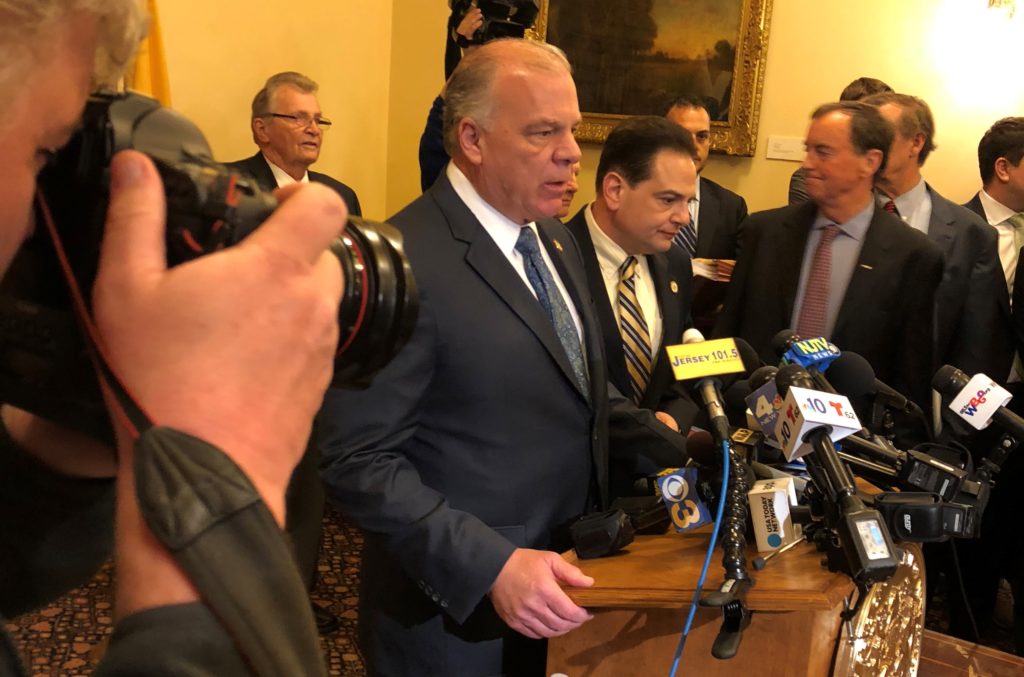Sparking 2% Cap Debate, Sweeney Knows Exactly what He’s Doing
Listen to audio version of this article

When Senate President Steve Sweeney (D-Gloucester) expressed his support for permitting local school districts to exceed the two percent spending cap to offset cuts in state aid, the immediate reaction was that he had stepped off the ledge and plunged into the political Hades that awaits anyone who flirts with the possibility of increasing property taxes.
Perhaps. But like most kneejerk responses, they failed to peek below the surface in search of a deeper motive. They embraced the conventional wisdom that any legislator who cozied up to property tax increases risked a rapid ride to the oblivion of former office holders.
Sweeney has been a Senator for 18 years and Senate President for 10. He is not new to the game.
His suggestion to permit local districts to apply for a waiver to exceed the spending cap was not a slip of the tongue, or a comment taken out of context or misconstrued. His eyes were wide open and he was well aware of precisely what he had proposed.
He accomplished what he set out to do — force a debate on the need to revise the state’s school aid formula to eliminate the unfairness which has plagued the system for years while, at the same time, offer some relief to districts forced by the loss of state aid to cut or eliminate programs, extra-curricular activities and implement teacher layoffs.
It may have been a calculated risk, but one that Sweeney fully understood before he made the leap knowing full well that the response of the governor’s office would be to accuse him of calling for local tax increases while opposing the Administration’s repeated demands for a tax increase on incomes above $1 million.
Sweeney sought to ratchet up the pressure on Murphy to deal with the hardships confronted by those districts which enjoyed years of overfunding but lost the aid through last year’s legislatively-mandated phase out designed to fully fund the aid formula.
Sweeney rapidly characterized the governor’s call for the millionaire’s tax as political demagoguery and correctly pointed out that any revenue raised would simply be allocated to the existing aid formula and would offer no relief to the approximately 200 districts which suffered aid cuts and forced to cope with the impact on programs and workforce levels.
By providing that affected districts seek a waiver to exceed the spending cap, the onus has been placed on local boards of education to demonstrate that any further budget cuts will severely damage their ability to provide a quality education and that an increase in property taxes is the only viable alternative.
Sweeney’s proposal was opposed by Senate Minority Leader Tom Kean Jr. (R-Union) as well who called for action on a broader front, specifically an overhaul of the entire school aid formula.
Should Sweeney forge ahead with his plan, it is unlikely there will be any Republican support.
The Senate President’s troubled relationship with the Administration has dominated Statehouse politics and policies since Murphy assumed office in 2018.
He’s jousted with the governor over his legislative agenda and, with a unified caucus behind him, has been able to stymie the Administration on issues great and small.
He is a shrewd political tactician frequently outmaneuvering the governor while wielding the power of his office to re-assert the dominance of the Senate.
By moving to establish the school aid program as a major subject of debate in the upcoming legislative session, Sweeney has taken a lead role in what could be a defining debate over an issue which has bedeviled Legislatures and Administrations for more than 40 years.
It will likely extend beyond the single issue of allowing the lifting of the spending cap and delve deeper into the structure of the formula and its application as well —- the point raised by Kean.
It will also provide Sweeney the platform and the opportunity to promote his “Path To Progress” study which, among many other recommendations, calls for consolidating some 300 K-6 districts into larger K-12 districts.
Sweeney has once again established the frame of reference for a policy debate of far-reaching consequence and, at the same time, forced Murphy into responding to the plight of those school districts facing budgetary difficulties.
The Senate President may have stepped off the ledge with his lift the cap idea, but he strapped on a parachute before doing so.
He seems quite confident that the chute will pop open when he yanks the ripcord.
Carl Golden is a senior contributing analyst with the William J., Hughes Center for Public Policy at Stockton University.










NJ school property tax (hidden in rents/mortgages) is NOT based on fairest Ability to Pay……need enhanced income tax brackets to bring all.. up to/down.. to ‘Adequacy Level’.
Why can’t over-funded schools cut costs?
Lyin’ Steve Sweeney, the D.I.N.O. that he is, is one of the politicians that teamed up with Governor Krispie Kreme to put the cap into place in the first place and he wants us to believe that he “saw the light” and how “wrong” it is? It’s nothing more than a political stunt in order to burnish his “working man’s” reputation he’s nothing more than a bought and paid for stooge by the Norcross Gang.